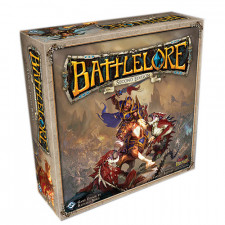BattleLore 2nd Edition Review
on Apr 21, 2015
Richard Borg practically created a brand new genre in Commands & Colors, a brilliant wargame engine that covers topics ranging from the American Civil War to World War II, fantasy, and beyond. The simple card-play and sectioned game board mechanisms interlock neatly to create quick-playing, entry-level games--or even hardcore competitive war games with the right implementation and expansion set. Its malleability has proven to be its greatest strength, as it stretches and expands nicely with each new release. Unfortunately, Fantasy Flight’s new implementation of BatteLore may well have stretched the system to its breaking point. While the same great gameplay is there, lurking under a crust of giant plastic miniatures, cards of various sizes, and mountains of tokens and other goodies, in the end, players are going to have to decide for themselves if the upgrades are worth the extra work.
BatteLore may not hold the dubious honor of being the most rules-heavy iteration of C&C, but it’s definitely one of the more complex variations. Instead of good old-fashioned pre-built matchups, the new scenario generator makes up the better part of all the new bloat. Rather than simply having players pick a battle, pile up their plastic troops, and get to the slaughter, the developers have taken a page from miniature wargaming. Players first draft a scenario card, which determines the board’s terrain layout and special rules and victory conditions. Then, they spend points drafting an army and some decoys, which they secretly deploy using FFG’s signature mini cards. Then players will reveal their battle lines, pull all the mini cards back off the board, and finally replace them with plastic dudes.
It’s kind of neat in a way, as you end up with hundreds of possible scenarios. Maybe one side is trying to hold the final bridge from collapsing while their mortal enemies are trying to occupy a town across the river, or maybe one team is trying to burn the forests to the ground and the other has to get a specific type of unit to take the high ground. It lets players approach tactical problems from a new angle, drafting units that complement both each other as well as the objectives. For players that like building their own armies and tweaking units, fretting over whether to spend three points for this guy or four points for this slightly better guy, it’s definitely going to be the most comfortable version of C&C yet.
But for all the game’s innovation, I’m left wondering if it’s all worth it in the end. Commands and Colors is traditionally a moderately luck-based, tactical brawl, one that roars across your table for an hour, makes its point, and gets the heck back on the shelf. The newfound emphasis on careful setup and army building kind of fly in the face of the design philosophy. You find yourself painstakingly drafting units, cunningly arranging your battle formations, and min/maxing your army--a process that seems to take as long as the battle itself--only for the dice and cards to decide the game anyway. It tries to be both a customizable minis game as well as a C&C battle game, and I just don’t think it fully succeeds at either.
In addition to the usual gameplay structure of Command-Order-Move-Attack, the game has a Lore system as the centerpiece of its design. If you’re not rolling well in battle, as a consolation you may generate some Lore tokens, which allow you to play the game’s most powerful command cards. This does add a nice touch, helping to differentiate the different factions from one another, but as with the other additions, the rules overhead may not be worth it.
I’m also not sold on the game’s victory conditions. On the one hand, they are much more interesting than most of the other games in the system, where you’re just trying to kill as many units as you can. But the emphasis on holding hexes at the end of your turn means you’re going to stupidly rush out of your lines to cash in on a VP hex, and the game is going to reward that kind of play. Commanding an army feels more like tactically exploiting a unit here, a card there, a terrain feature there, rather than overseeing a large, well-coordinated line advance. So whatever improvements were made to the system feel washed out by the strange gaminess that is introduced.
Now to be sure, the disjointed feel can create some extremely memorable set pieces. We had giant demonic monsters stomping through the woods, cavalry rushing by and taking a swipe, a sneaky group of archers creeping around a strategically valuable hill, and countless other awesome cinematic moments. Where some games built on this system can kind of fizzle out as unit counts dwindle, this one tends to go down to the wire, driving players to near madness as they try to work out how they can get just one more hex of movement to push the enemy out of key areas and rule the day. BatteLore bills itself as a game of fantasy battles, and at least on that level it’s a resounding success.
If you’re simply a C&C fan looking for another fast and furious implementation of the system, don’t throw away your copy of Ancients or Napoleonics just yet. But if you start breathing heavily at the thought of tweaking army lists, expanding your favorite squads with new and better units, and outthinking your opponents as you place your plastic dudes, BatteLore may just right for you.

 Customer Support
Customer Support  Subscribe
Subscribe 




 Account
Account  Wishlist
Wishlist 

